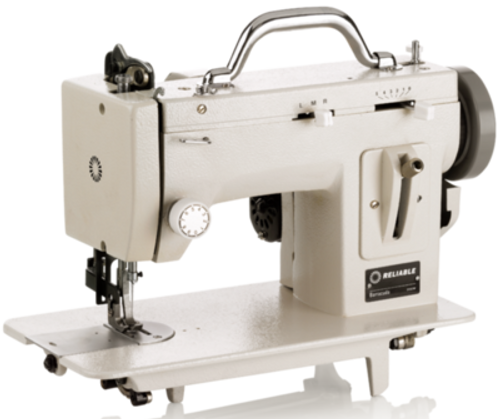Meet the Barracuda 200ZW, a portable walking foot machine that brings joy to sewers. Ideal for boat owners and hobbyists, it excels in medium to heavy-weight sewing, effortlessly handling challenging materials like 8 layers of Sunbrella Plus. With top and bottom feeding, it delivers perfect stitches. Note: Not suitable for thin fabrics used in clothing or lightweight applications. Each machine is tested and set up by master technicians; please allow 3-5 business days for shipping.
The Barracuda zig-zag and straight stitch portable walking-foot machine is remarkably versatile. Designed for boat owners, hobbyists, and small businesses, the Barracuda is ideal for medium- to heavy-weight sewing jobs. With a stitch quality comparable to an industrial machine, there’s no job too big for the Barracuda. With top and bottom feeding, it produces a perfect, even stitch, even when sewing over challenging materials.
UP TO 8 LAYERS OF SUNBRELLA-PLUS
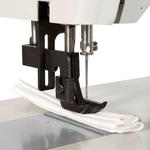
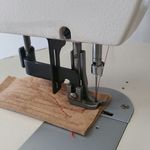
A full 1/4" clearance under the foot allows the Barracuda to sew 10 or more layers of heavy canvas or up to 8 layers of Sunbrella-Plus (top of the line material for boats)
BUILT-IN SPEED REDUCER
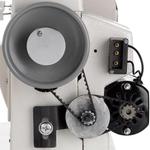
The built-in speed reducer gives the machine extra torque to get through the toughest jobs.
OPTIONAL .47" WELTING FEET SET
Reliable 1/4" Inner & Outer Welt Feet Foot Set for Barracuda 200ZW Portable Walking Foot Sewing Machines

Leave it to the folks at Reliable to come up with a full size .47" welting feet set for the Barracuda 200ZW (choose in dropdown above).
FEATURES:
- Stitch width (0-5mm) adjustment lever
- Up to 4 stitches per inch
- Sews Sunguard UVR Bonded Polyester thread and #69 nylon
- Up to 12 mm foot clearance (upon request only)
- Toothed belts and pulleys to prevent slippage
- Type 135 x 17 needles, 135x16 for leather
Machine is available with optional Craftsman Package (below) for $200 more!
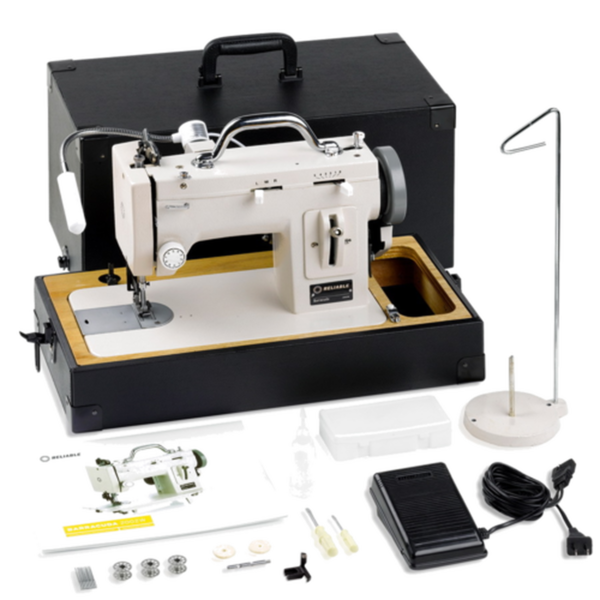
Guest Article on Sail Making by Todd Bradshaw

Article Source: http://forum.woodenboat.com/showthread.php?200481-Straight-stitching-a-sail
Author - Todd Bradshaw's Avatar: Todd Bradshaw - Wood B. Good
Re: Straight stitching a sail
Felled seams on modern Dacron would be quite difficult to make, especially on a computer-cut sail because computers cut panels with curved edges instead of broadseaming. Plus, the fabric is awfully stiff for that sort of seam. Two lines of straight stitches can be used (V46 or V69 thread and a #16 or #18 needle and about 8-10 stitches per inch) but as mentioned, it isn't ideal for strength because it is making what are essentially perforated lines on the sail that kind of say "tear here". This is accentuated by the tearing properties of modern, resin-coated Dacron.
Unlike most other fabrics, Dacron's low stretch means that the individual yarns don't help each other out much when stress is applied. Essentially, the first yarn tries to take all the stress (until it breaks) then the second yarn does the same thing and this scenario just repeats over and over, yarn after yarn. This is why I can take a hunk of heavy Dacron sailcloth (12 oz. or better) give it a sharp tug and tear it right in half. Even though it happens quite fast, I'm essentially only having to tear one yarn at a time. Other synthetics, like nylon, work differently. Stress will concentrate on the first yarn, but will also be spread out to some extent to its neighboring yarns. We take advantage of the Dacron's non-stretch properties in order to make sails that will keep their designed shape in use, but we make allowances to preserve it's strength where we can. The typical zig-zag puts maybe a quarter of an inch or more between the needle holes and yields seams with a higher tear strength and less in the way of a perforated line.
The other thing that really helps is double-sided seam basting tape. Not only does it instantly make sewing easier, keeping panels aligned for seaming, but it adds a tremendous amount of seam strength. Once the adhesive has had a week or two to completely cure (dwell time) it makes seams that are hard to disassemble without messing up the cloth.
The various types of seams would probably grade out like this:
Strongest - Seam tape with two lines of zig-zag stitching (maybe 3 lines, with wider seam overlaps, and heavier cloth on big offshore sails).
Production Sails - Many of these are now sewn with a 3-step machine, which sews a single line of stitches in a wider zig-zag pattern, but each zig or zag is actually made up from three straight stitches. Less strength, but the sail only needs half as many passes through the sewing machine, making them cheaper to build. Good ones are seam-taped first. Not so good ones are seam "basted" by pricking the fabric with a hot knife with a tiny needle-like tip every few inches, melting the layers together. It saves a substantial amount of time, but adds no additional strength to the seams beside that of the stitches.
Straight stitching - Even when tape-basted and double-stitched, the lines of perforations are still a concern, but they still may be as good or better than a needle-basted 3-step seam because the tape adds so much strength to the seams. If straight stitching is all you have and you aren't planning on crossing any oceans, you can probably get away with it. Sailrite's plotter cuts with a spinning cutting wheel that generates enough heat to slightly melt the cloth - so the fact that you aren't pinning down the cut edges of the seams with a zig-zag probably won't be a problem. On hand-cut edges, it likely would cause some raveling.
Lap-feld seams with two lines of straight stitching were (still are) the norm on cotton sails and are quite strong, but cotton has far more stretch than Dacron, so the perforated lines aren't a problem. They also work great on nylon and other soft synthetics (backpacking tents, clothing, and even hot-air balloons - we used to be required to use them for patching balloons when I worked on them). Zig-zag stitching is less popular on these things because the stitches are easier to snag and tear.













